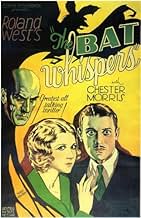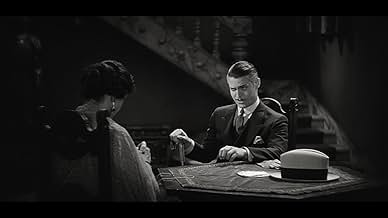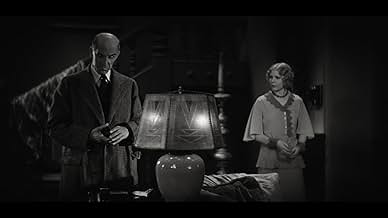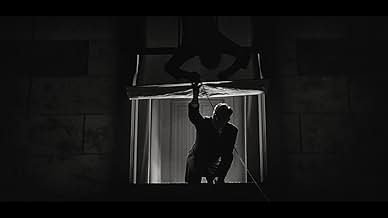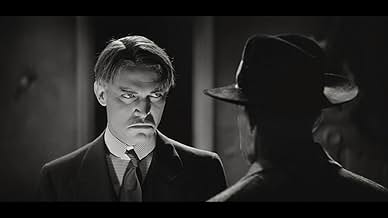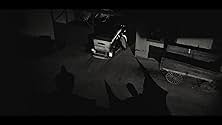CALIFICACIÓN DE IMDb
6.3/10
1.4 k
TU CALIFICACIÓN
Agrega una trama en tu idiomaA master criminal terrorizes the occupants of an isolated country mansion.A master criminal terrorizes the occupants of an isolated country mansion.A master criminal terrorizes the occupants of an isolated country mansion.
- Dirección
- Guionistas
- Elenco
- Premios
- 2 premios ganados en total
- Dirección
- Guionistas
- Todo el elenco y el equipo
- Producción, taquilla y más en IMDbPro
Opiniones destacadas
I've watched the 1926, 1930 and 1930 wide screen versions many times over the years. However, the other day I finally watched the widescreen on my 5x6 foot screen which I usually save for 3D and football. The details really jumped out. There are so many wonderful camera tricks, many of which I cannot explain. As a professional modeler I can say that the miniatures were far ahead of their time, as was the skill in photographing them. They probably were only exceeded beginning with the Star Wars attack on the death star.
The fluidity of the camera was amazing for its time. The old lady and the maid walk down a long corridor, talking all the time as the camera moves ahead of them. They walk into a room and sit at a table which was right in the path of the camera. Later in the film a character vaults over a 3 foot wall and runs down a path with the camera following him, apparently right through the wall. The shadows of the Bat as he hulks on the floor are inhuman. On several startling occasions the characters jump right into the camera. These and more have been mastered for years but this film discovered them. If you are familiar with the climax of The Alibi, you remember the special effect that seemed almost real, not surpassed until CGI. The Bat Whispers is filled with such effects.
Yes, the film is static, despite all the goings on. And the acting, although unacceptable by 1932 standards was about average for 1930. However, I would gladly have strangled Maude Eburn who ruined every scene she was in. The Bat Whispers is really a guilty pleasure for modelers, cinematographers and horror fans.
The fluidity of the camera was amazing for its time. The old lady and the maid walk down a long corridor, talking all the time as the camera moves ahead of them. They walk into a room and sit at a table which was right in the path of the camera. Later in the film a character vaults over a 3 foot wall and runs down a path with the camera following him, apparently right through the wall. The shadows of the Bat as he hulks on the floor are inhuman. On several startling occasions the characters jump right into the camera. These and more have been mastered for years but this film discovered them. If you are familiar with the climax of The Alibi, you remember the special effect that seemed almost real, not surpassed until CGI. The Bat Whispers is filled with such effects.
Yes, the film is static, despite all the goings on. And the acting, although unacceptable by 1932 standards was about average for 1930. However, I would gladly have strangled Maude Eburn who ruined every scene she was in. The Bat Whispers is really a guilty pleasure for modelers, cinematographers and horror fans.
Yes, this film is dated. The acting is beyond hammy; only in the early talkies did movies contain this kind of unabashedly theatrical performing. Just when you think Chester Morris couldn't possibly twist his mouth--or curl his eyebrow--or twirl his finger--in a new way, he surprises you and offers a wholly different mugging expression he hadn't pulled out before. Along with the acting, the genre (the creepy old house with hidden panels etc.) became old hat by 1950. So, all right, this movie is stilted and creaks. However, for a film antiquarian, this motion picture is a joy. Its sets and lighting are breathtaking, and one gathers from it why the play was one of the longest running on Broadway at the time. I'll take it over the Vincent Price remake, THE BAT, anyday and I love Vincent Price.
Based on a play that was filmed four years earlier by the same director this is a wonderful film that is hampered only by the limitations of sound. That said this is probably the best version of the story.
A fiend known as The Bat is lurking around the mansion of a rich family and its up to an intrepid detective to prevent him from getting the goods.
This movie is a lot of fun, with several wonderful performances especially by Chester Morris as the detective.
Interestingly the film was filmed both in the standard aspect ratio and in an early wide screen process (Both are on the DVD). The films are more or less identical, but since they were taken from different takes they both play like two different nights of the same play.
I like this film a great deal and recommend it to anyone who likes the Old Dark House genre.
A fiend known as The Bat is lurking around the mansion of a rich family and its up to an intrepid detective to prevent him from getting the goods.
This movie is a lot of fun, with several wonderful performances especially by Chester Morris as the detective.
Interestingly the film was filmed both in the standard aspect ratio and in an early wide screen process (Both are on the DVD). The films are more or less identical, but since they were taken from different takes they both play like two different nights of the same play.
I like this film a great deal and recommend it to anyone who likes the Old Dark House genre.
From the memorable opening scene of the newsboy yelling "You won't get the Bat! I'll bet the Bat makes a chump out of you!" to the police, it was clear this would be a much more stylish film than the 1926 one. Roland West directed both films. This one is markedly superior visually and, unlike a lot of other directors at the time, West seems to make the transition from silent to sound filmmaking seamlessly. I've seen all three versions of The Bat and enjoyed them all but this is probably the best version. This is also the version that, according to Bob Kane, was part of the inspiration for Batman. The Bat looks less silly here than in the last movie, where he had big mouse ears and was more adorable than scary. Anyway, it's a good old dark house thriller with a cool beginning and an amusing ending. Any movie with Una Merkel in it can't be that bad.
Roland West first filmed the story of the Bat, a killer that steals money and jewels for their value as well as for adventure, in 1926. He then made The Bat Whispers in 1930, which is a sound version of his silent film. The transition is not entirely smooth yet rewarding. Let me first state that the silent film is easily the superior of the two. The silent film had a much more creepier feeling to it. The acting was far superior, and the sets were incredible. West does duplicate much of the sets and shots that were in his first version. The acting, however, is not very good as it is obvious that sound pictures have not been around too long. West tries to accommodate that new innovation which sometimes results in stagey scenes and long dialogue sessions. Chester Morris is...well, to say the least...a ham. His performance is a bit over-the-top for me. He does show glimmers of talent though. The story is pretty much the same and that is the film's strength. It's a fun mystery that by today's standards will seem crude and silly, but taken in context of its time should provide some entertainment. Oddly enough, the mystery seemed less mysterious in this version. I knew who the killer was with ease(trying to distance myself from the memory of the first film as I did this). West again has some impressive camera shots. The opening scene of the bat stealing a jewel from an apartment high in the sky was incredible as was the journey of the bat over a bank and following a man with a lot of money. The camera work of West is innovative, and it is a pity that his life was cut short and we did not get a chance to see him employ his talents in other projects.
¿Sabías que…?
- TriviaOne of only a handful of films to be shot in the widescreen Magnifilm 65mm format (other studios were also experimenting with other wide formats at the time). The expense of upgrading theaters with new screens and projectors - after just having to install sound equipment - coupled with the Depression and the December 1930 edict from the MPPDA that the film industry not cause "the public's curiosity to be aroused about any new innovations for at least two years" effectively killed the new format. Widescreen formats did not return until the middle of the 1950s out of the necessity to compete with television.
- ErroresAfter the bank robbery, there is a obvious slot in the "road" where the miniature car travels.
- Citas
The Unknown: What I'd like to know is how did you get the dope from headquarters on this case?
Detective Anderson: The same way I get everything, with my mind. I've got the greatest brain that ever existed.
- Créditos curiososAfter the film an actor comes onto a movie house stage and implores the audience to withhold the identity of the bat from family and friends so they can also enjoy the movie.
- Versiones alternativasThis film was shot in two versions with a different director of photography for each. One is in standard 35mm and the other in an early 65mm process. The 65mm version is considered "stagebound" (it was actually based on a popular play) while the 35mm version is considered more "cinematic". Prints of both versions still exist.
- ConexionesFeatured in Cinemassacre Video: Bat-a-Thon (2008)
Selecciones populares
Inicia sesión para calificar y agrega a la lista de videos para obtener recomendaciones personalizadas
- How long is The Bat Whispers?Con tecnología de Alexa
Detalles
- Fecha de lanzamiento
- País de origen
- Idioma
- También se conoce como
- Roland West's The Bat Whispers
- Productora
- Ver más créditos de la compañía en IMDbPro
- Tiempo de ejecución
- 1h 24min(84 min)
- Color
- Mezcla de sonido
Contribuir a esta página
Sugiere una edición o agrega el contenido que falta

